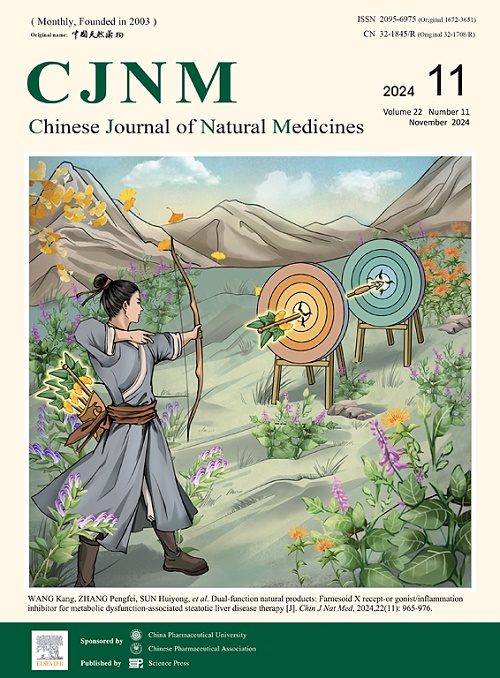Harmonizing tradition and technology: Liposomal nanocarriers unlocking the power of natural herbs in Traditional Chinese Medicine
IF 4.9
2区 医学
Q1 INTEGRATIVE & COMPLEMENTARY MEDICINE
引用次数: 0
Abstract
Natural herbs demonstrate significant therapeutic potential in managing chronic and complex diseases; however, their clinical application faces limitations due to low bioavailability, instability, toxicity, and herb-drug interactions. Furthermore, insufficient standardized evidence and global acceptance impede their widespread adoption. Liposomes, nanocarriers consisting of a phospholipid bilayer enclosing an aqueous core, present a promising approach for enhancing the pharmacokinetics and therapeutic efficacy of herbal compounds. These adaptable systems can encapsulate both hydrophilic and hydrophobic agents, enabling targeted drug delivery and enhanced stability. Moreover, liposomes can be modified to carry diagnostic and imaging agents, enabling precise disease detection and monitoring. While liposomes offer potential as an innovative delivery technology for herbal remedies, their application in Traditional Chinese Medicine (TCM) remains relatively unexplored. TCM, with its holistic, energy-based approach to health and organ function, presents distinct challenges regarding formulation and delivery. This review examines the therapeutic potential of herbal medicines, emphasizing how liposomes address delivery challenges within the TCM framework. It also investigates the integration of TCM with Western medical practices, demonstrating how liposomal systems may bridge these approaches. The review analyzes key formulation techniques for TCM-loaded liposomes, particularly the microfluidic method, which demonstrates superior control over particle size and encapsulation efficiency compared to conventional methods. The analysis addresses barriers to integrating liposomal delivery systems with TCM, including physicochemical properties, scalability issues, and regulatory challenges. Finally, this review provides strategic recommendations for overcoming these obstacles and identifies future research directions to maximize the potential of liposomal technology in enhancing TCM therapies.
调和传统与技术:脂质体纳米载体释放天然中药的力量
天然草药在治疗慢性和复杂疾病方面显示出巨大的治疗潜力;然而,由于低生物利用度、不稳定性、毒性和草药相互作用,它们的临床应用面临限制。此外,缺乏标准化证据和全球接受程度阻碍了它们的广泛采用。脂质体是一种由包裹水核的磷脂双分子层组成的纳米载体,是一种很有前途的提高草药化合物药代动力学和治疗效果的方法。这些适应性强的系统可以封装亲水性和疏水性试剂,从而实现靶向药物递送和增强稳定性。此外,脂质体可以被修饰以携带诊断和显像剂,从而实现精确的疾病检测和监测。虽然脂质体作为一种创新的给药技术具有潜力,但它们在中药中的应用仍相对未被探索。中医以其整体的、以能量为基础的健康和器官功能方法,在配方和递送方面提出了独特的挑战。这篇综述探讨了草药的治疗潜力,强调了脂质体如何在中医框架内解决递送挑战。它还研究了中医与西方医学实践的整合,展示了脂质体系统如何连接这些方法。本文分析了中药脂质体的关键配方技术,特别是微流控法,与传统方法相比,微流控法在粒径和包封效率方面具有优越的控制能力。该分析解决了将脂质体递送系统与中药整合的障碍,包括物理化学性质、可扩展性问题和监管挑战。最后,本文提出了克服这些障碍的策略建议,并确定了未来的研究方向,以最大限度地发挥脂质体技术在中医治疗中的潜力。
本文章由计算机程序翻译,如有差异,请以英文原文为准。
求助全文
约1分钟内获得全文
求助全文
来源期刊

Chinese Journal of Natural Medicines
INTEGRATIVE & COMPLEMENTARY MEDICINE-PHARMACOLOGY & PHARMACY
CiteScore
7.50
自引率
4.30%
发文量
2235
期刊介绍:
The Chinese Journal of Natural Medicines (CJNM), founded and sponsored in May 2003 by China Pharmaceutical University and the Chinese Pharmaceutical Association, is devoted to communication among pharmaceutical and medical scientists interested in the advancement of Traditional Chinese Medicines (TCM). CJNM publishes articles relating to a broad spectrum of bioactive natural products, leading compounds and medicines derived from Traditional Chinese Medicines (TCM).
Topics covered by the journal are: Resources of Traditional Chinese Medicines; Interaction and complexity of prescription; Natural Products Chemistry (including structure modification, semi-and total synthesis, bio-transformation); Pharmacology of natural products and prescription (including pharmacokinetics and toxicology); Pharmaceutics and Analytical Methods of natural products.
 求助内容:
求助内容: 应助结果提醒方式:
应助结果提醒方式:


